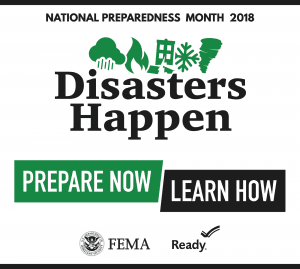
National Disaster Preparedness Month
13 Top Resources to Get Your Building ReadyReady.gov recognizes each September as National Preparedness Month, using it as an opportunity to remind the community about the importance of disaster preparation.
Given that facilities teams play such a critical role before and during emergencies, we’re using this focus as a reason to provide some of the best free resources to assist facility managers with disaster preparedness.
 In this article, we’ll provide links and short overviews of 13 top resources to give you a boost no matter where you are in the emergency preparation process.
In this article, we’ll provide links and short overviews of 13 top resources to give you a boost no matter where you are in the emergency preparation process.
Emergency Prep Resources to Start With
Even for managers of relatively small facilities, preparing for emergencies can be an overwhelming task. If you’re not sure where to start, these risk assessment resources, from Ready.gov and the American Red Cross, will point you in the right direction.
- The American Red Cross Ready Rating Program: This free program is designed to help organizations self-assess their emergency preparedness. Complete the comprehensive assessment and “put all of your preparedness ducks in a row.”
- Ready.gov Risk Assessment Page: On this page, read about the basics of risk assessments and access resources—such as FEMA’s risk assessment tool—specifically designed to help you assess a variety of hazards your organization may face.
Natural Hazards and Disaster Preparation Resources
Natural disasters are among the most dangerous and expensive disasters that can occur. Hazards associated with extreme cold weather also pose a risk. Of course, the types of natural disasters and hazards you’ll face vary by geography. So we’ve compiled a few different playbooks from Ready.gov and checklists from the Small Business Administration to get you prepared for whatever danger nature might present to your facility.
- How to Prepare for an Earthquake: “This hazard-specific guide provides information on the basics of each hazard, how to protect people and property, and what steps to take now.”
- Winter Weather Preparedness Checklist: Make sure every base is covered when preparing your facility for the threat of cold winter weather.
- Inland Flooding Ready Business Toolkit: A program designed to enable you to deploy tactics to protect employees, customers, and ensure business continuity. This resource is also helpful for organizations facing flooding caused by hurricanes.
- Tornado Preparedness Checklist: Tornadoes develop with little to no warning. Make sure you’re prepared with this checklist that gets you ready before, during, and after a tornado.
- Wildfire Preparedness Checklist: Wildfires have become the new normal in the Western United States. Use this OSHA checklist as a guide through the tasks you need to complete to be truly prepared.
Resources to Spread Preparedness Awareness
It’s so easy to fall into the “it could never happen to us” trap. After all, it’s human nature to put off things that don’t appear to have an immediate impact. But the threat to safety and business continuity caused by a lack of preparedness and emergency response is all too real.
Once you’ve gotten the lay of the emergency preparedness land, these resources will help build the necessary sense of urgency among your team and executives.
- Knowing Your Gaps is Key to Catastrophe Preparedness: In partnership with AIIM, ARC conducted a comprehensive study of the costs and frequency of disasters faced by facilities across the United States. This ebook presents the findings of that study.
- Emergency Infographic: Key statistics from the ebook above are presented in this infographic that can be easily shared with your team and execs to increase a sense of urgency.
- Ready Business Resources: The Department of Homeland Security (DHS) suggests using these resources that they’ve developed along with FEMA to help “sharpen your case for the needed leadership commitment to start the process of adopting a plan.”
Resources for Creating a Plan
When it’s actually time to start putting a plan down on paper, you’ll need some help from the experts to make sure you’ve covered everything. Fortunately, there’s no shortage of resources to guide you through every step of the way.
- DHS: Prepare Your Business for an Emergency: This resource from the Department of Homeland Security takes you through the five steps of creating a preparedness program, including Program Management, Planning, Implementation, Testing, and Program Improvement.
- Emergency Action Plan Template: As part of the Red Cross program referenced above, access is included to an EAP template from which you can create a customized plan.
- 4 Ways to Prepare Your Building, School or Campus: This paper, while mostly focused on campus-specific emergencies, contains tactics and strategies that any facility manager can use.
A Final Resource to Tie it All Together
Identifying hazards, creating plans, and training your team are all vital steps for being prepared when the next emergency hits. But when it comes time to put those plans into action, the linchpin is communication.
In other words, a successful emergency response and recovery is all about getting the right information—whether it’s an action plan or an evacuation map—to the right person at the right time.
ARC’s Emergency and Life Safety dashboard does just that by mobilizing your emergency plans and building documentation. So study these resources, then put your plans into action with the help of ARC’s mobile facilities dashboards.
